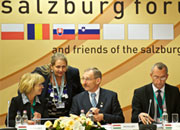Services:
I offer my interpreting services in the following modes:
- Simultaneous interpreting
- Consecutive interpreting
- Whispered interpreting
- Over-the-Phone Interpreting (OPI)
Other services offered
- Conference Interpreting Consultancy
- Written translation

Simultaneous interpreting
In simultaneous interpretation, the interpreter renders the message in the target-language as quickly as he or she can formulate it from the source language, while the source-language speaker continuously speaks; sitting in a sound-proof booth, the SI interpreter speaks into a microphone, while clearly seeing and hearing the source-language speaker via earphones. The simultaneous interpretation is rendered to the target-language listeners via their earphones.

Consecutive interpreting
In consecutive interpreting, the interpreter speaks after the source-language speaker has finished speaking. The speech is divided into segments, and CI interpreter sits or stands beside the source-language speaker, listening and taking notes as the speaker progresses through the message. When the speaker pauses or finishes speaking, the interpreter then renders the entire message in the target language.
Consecutively interpreted speeches, or segments of them, tend to be short. Often, the interpreter asks the speaker to pause after each sentence; sentence-by-sentence interpreting requires less memorisation, yet, its disadvantage is in the interpreter's not having heard the entire speech or its gist, therefore making more difficult establishing the accurate register by not knowing the exact vocabulary and terms to use. This method is usual in rendering speeches, depositions, recorded statements, court witness testimony, and medical and job interviews.
Consecutive interpreting allows for the source-language message's full meaning to be understood before the interpreter renders it to the target language. This affords a truer, accurate, and accessible interpretation than does simultaneous interpretation.

Whispered interpreting
In whispered interpreting (chuchotage, in French), the interpreter sits or stands next to the small target-language audience whilst whispering a simultaneous interpretation of the matter to hand; this method requires no equipment. Chuchotage is used in circumstances where the majority of a group speaks the source language, and a minority (ideally no more than three persons) do not speak it.

Over-the-Phone Interpreting (OPI)
Also known as remote interpreting, this term refers to interpreting services provided via telephonic links (occasionally with video links as well), in which neither the interpreter nor the parties are in the same physical location. Interpreters tend to work in medical, social service, business and legal cases. At present, most of telephone interpreting is done consecutively, but as telecommunications technology develops further, simultaneous interpreting will become more prevalent.
This type of interpreting is used for business negotiations or talks, when great distances are involved (e.g., one partner is based in Germany and another in the UK). It is also used during preparations for business meetings when arrangements have to be made between the business partners. Three-way teleconferences are the preferred option for this method of interpreting. The biggest asset of this method is that costs are lower than organising a full meeting.
Other services offered
Conference Interpreting Consultancy
I can provide conference organisers, meeting planners a full range of interpreting services for most languages making use of the large database of experienced colleagues and equipment providers for meetings in Hungary or in Europe.

Written translation
Please note, that despite being used interchangeably, interpretation
and translation are not synonymous,
but refer, respectively, to the spoken and written transference
of meaning between two languages.
Translation is the action of interpretation
of the meaning of a text, and subsequent production of
an equivalent text, also called a translation, that communicates
the same message in another language. The text to be translated
is called the "source text", and the language
it is to be translated into is called the "target language";
the final product is sometimes called the "target text."
I can do and arrange for you written translation and proofreading
in the desired language combination.
My specialities are
- politics,
- law enforcement
- finances, audit
- medical science
- dentistry
- migration
- economy
- health care

- education
- business management
- media
- legal
- labour and social affairs




